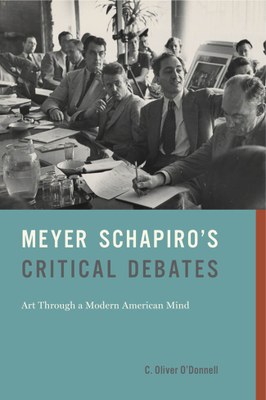Dr. C. Oliver O`Donnell
Preisträger Willibald-Sauerländer-Preis 2019. Forschungsaufenthalt am Zentralinstitut für Kunstgeschichte, Juli 2019
Vita
- 05/2016 | PhD, History of Art, University of California, Berkeley
- 12/2005 | AB, Art History and Archaeology, Washington University in St. Louis, MO
Selected Publications
Monographs
- 2019 | Meyer Schapiro’s Critical Debates: Art Through a Modern American Mind, forthcoming with The Pennsylvania State University Press
Journal Articles
- 2018 | Two Modes of Mid-Century Iconology, History of Humanities vol.3, no.1 (Spring 2018)
- 2018 | Revisiting David Summers’s Real Spaces: a neo-pragmatist interpretation, World Art vol.8, no.1 (January 2018)
- 2017 | Berensonian Formalism and Pragmatist Perception, Zeitschrift für Ästhetik und Allgemeine Kunstwissenschaft vol.62, no.2 (2017)
- 2017 | Depicting Berkeleyan Idealism: a study of two portraits by John Smibert, Word & Image vol.33, no.1 (March 2017)
- 2016 | Reading Allan Marquand’s “On Scientific Method in the Study of Art”, European Journal of Pragmatism and American Philosophy vol.8, no.2 (December 2016)
- 2016 | Transcription of Allan Marquand’s “On Scientific Method in the Study of Art”, European Journal of Pragmatism and American Philosophy vol.8, no.2 (December 2016)
- 2016 | Meyer Schapiro, Abstract Expressionism, and the Paradox of Freedom in Art Historical Description, Tate Papers no.26 (Autumn 2016)
[Stand: 2019]
________________________
C. Oliver O`Donnel über seine mit dem Willibald-Sauerländer-Preis 2019 prämierte Publikation "Meyer Schapiro’s Critical Debates: Art Through a Modern American Mind"

Meyer Schapiro (1904-1996) was a close friend to many of the famous artists of his generation and a scholar who engaged in public debate with some of the major intellectuals of his time. This book, expanded from my PhD dissertation, synthesizes his prolific career, demonstrating how Schapiro worked from the nexus of artistic and intellectual practice to confront some of the twentieth century’s most abiding questions.
Schapiro was renowned for pioneering interdisciplinary approaches to interpreting visual art. His lengthy formal analyses in the 1920s, Marxist interpretations in the 1930s, psychoanalytic critiques in the 1950s and 1960s, and semiotic explorations in the 1970s all helped open new avenues for inquiry. Based on archival research, my study is structured chronologically around eight defining debates in which Schapiro participated, including his dispute with Isaiah Berlin over the life and writing of Bernard Berenson, Schapiro’s critique of Martin Heidegger’s ekphrastic commentary on Van Gogh, and his confrontation with Claude Lévi-Strauss over the applicability of mathematics to the interpretation of visual art. By analyzing these intellectual exchanges, my study aims not only to trace Schapiro’s philosophical evolution but also to relate Schapiro’s work to the development of art history as a discipline, to central tensions of artistic modernism, and to modern intellectual history as a whole.
Approaching Schapiro’s career in this way facilitates my effort to tie the separate strands of his work into one cohesive picture and my argument that the diversity of Schapiro’s scholarship is united by his recurrent, quite fraught, and life-long engagement with American Pragmatism. As a whole, the book aims to clarify Schapiro’s distinctive and substantial impact on the field of art history and on twentieth-century modernism.
